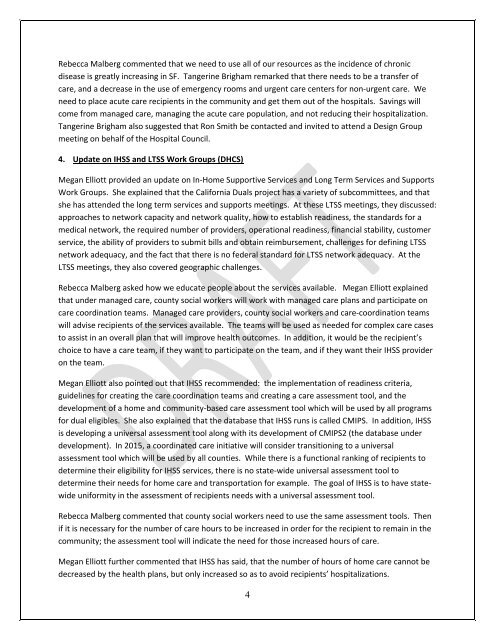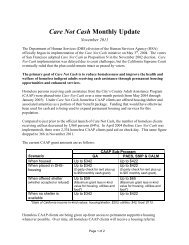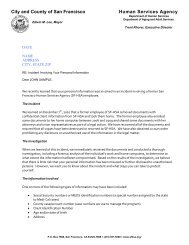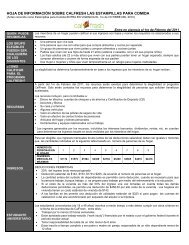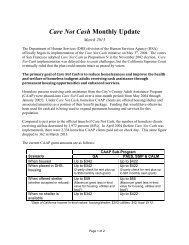May 21, 2012 - Human Services Agency of San Francisco
May 21, 2012 - Human Services Agency of San Francisco
May 21, 2012 - Human Services Agency of San Francisco
You also want an ePaper? Increase the reach of your titles
YUMPU automatically turns print PDFs into web optimized ePapers that Google loves.
Rebecca Malberg commented that we need to use all <strong>of</strong> our resources as the incidence <strong>of</strong> chronic<br />
disease is greatly increasing in SF. Tangerine Brigham remarked that there needs to be a transfer <strong>of</strong><br />
care, and a decrease in the use <strong>of</strong> emergency rooms and urgent care centers for non‐urgent care. We<br />
need to place acute care recipients in the community and get them out <strong>of</strong> the hospitals. Savings will<br />
come from managed care, managing the acute care population, and not reducing their hospitalization.<br />
Tangerine Brigham also suggested that Ron Smith be contacted and invited to attend a Design Group<br />
meeting on behalf <strong>of</strong> the Hospital Council.<br />
4. Update on IHSS and LTSS Work Groups (DHCS)<br />
Megan Elliott provided an update on In‐Home Supportive <strong>Services</strong> and Long Term <strong>Services</strong> and Supports<br />
Work Groups. She explained that the California Duals project has a variety <strong>of</strong> subcommittees, and that<br />
she has attended the long term services and supports meetings. At these LTSS meetings, they discussed:<br />
approaches to network capacity and network quality, how to establish readiness, the standards for a<br />
medical network, the required number <strong>of</strong> providers, operational readiness, financial stability, customer<br />
service, the ability <strong>of</strong> providers to submit bills and obtain reimbursement, challenges for defining LTSS<br />
network adequacy, and the fact that there is no federal standard for LTSS network adequacy. At the<br />
LTSS meetings, they also covered geographic challenges.<br />
Rebecca Malberg asked how we educate people about the services available. Megan Elliott explained<br />
that under managed care, county social workers will work with managed care plans and participate on<br />
care coordination teams. Managed care providers, county social workers and care‐coordination teams<br />
will advise recipients <strong>of</strong> the services available. The teams will be used as needed for complex care cases<br />
to assist in an overall plan that will improve health outcomes. In addition, it would be the recipient’s<br />
choice to have a care team, if they want to participate on the team, and if they want their IHSS provider<br />
on the team.<br />
Megan Elliott also pointed out that IHSS recommended: the implementation <strong>of</strong> readiness criteria,<br />
guidelines for creating the care coordination teams and creating a care assessment tool, and the<br />
development <strong>of</strong> a home and community‐based care assessment tool which will be used by all programs<br />
for dual eligibles. She also explained that the database that IHSS runs is called CMIPS. In addition, IHSS<br />
is developing a universal assessment tool along with its development <strong>of</strong> CMIPS2 (the database under<br />
development). In 2015, a coordinated care initiative will consider transitioning to a universal<br />
assessment tool which will be used by all counties. While there is a functional ranking <strong>of</strong> recipients to<br />
determine their eligibility for IHSS services, there is no state‐wide universal assessment tool to<br />
determine their needs for home care and transportation for example. The goal <strong>of</strong> IHSS is to have statewide<br />
uniformity in the assessment <strong>of</strong> recipients needs with a universal assessment tool.<br />
Rebecca Malberg commented that county social workers need to use the same assessment tools. Then<br />
if it is necessary for the number <strong>of</strong> care hours to be increased in order for the recipient to remain in the<br />
community; the assessment tool will indicate the need for those increased hours <strong>of</strong> care.<br />
Megan Elliott further commented that IHSS has said, that the number <strong>of</strong> hours <strong>of</strong> home care cannot be<br />
decreased by the health plans, but only increased so as to avoid recipients’ hospitalizations.<br />
4


